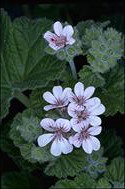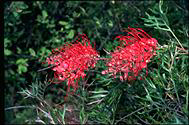

 |
Australian National Botanic Gardens
|
 |
A weekly news sheet prepared by a Gardens' volunteer.
Numbers in square brackets [] refer to garden bed Sections.
Plants in flower are in bold type.
26 November 2004
 |
|
Pelargonium australe
- click for larger image
|
For those who yearn to see the Tasmanian wildflowers, come, see a section of heathland below the carpark. Arriving at the bridge guarded by Bulbine bulbosa [Section 149] with yellow flowers arranged along the upright stems, view the splendid expanse of flowers, all in shades of white. Walking around, they include Ozothamnus ledifolius [Section 232], Ozothamnus purpurascens [Section 2231] and Ozothamnus expansifolius [Section 235]. The shrubs with even whiter daisies are those of Olearia ramulosa [Section 230]. A bank of Chrysocephalum apiculatum [Section 230] with upright stems has clusters of yellow button flowers. Walk around the pool surrounded by rocks, the haven of many slumbering Gippsland Water Dragons, Physignathus lesueurii howittii, while opposite, the bank is covered with Pelargonium australe [Section 237], small shrubs with soft rounded leaves and geranium-like flowers coloured pink with deeper veins. Behind the seat Prostanthera lasianthos [Section 237] is an upright shrub crowned with mauve flowers.
Leave this glorious section, and follow this more varied and colourful walk starting in the cultivar section on the far side of the Rainforest up the hill from the Cafe. Grevillea ‘Poorinda Royal Mantle’ [Section 124] is an ideal dense ground cover bearing pink toothbrush-like flowers. Callistemon ‘Howie’s Fire Glow’ [Section 124] with fiery red flowers sprinkled with yellow is one of the many bottlebrushes now in flower. In front, Callistemon ‘Harkness’ [Section 124] is tall with deep furrowed bark and soft red bottlebrushes. There is a row of these edging this road. Opposite Callistemon salignus [Section 126] is a tall upright shrub laden with pink flower spikes on the willowy branches. Derwentia perfoliata [Section 124] is a low dense plant with grey-green stem-clasping leaves along arching branches tipped with sprays of blue flowers. Rounding the corner Isotoma axillaris [Section 124] is seen in small clumps bright with its starry blue flowers. Opposite a tall dense small tree, Calistemon salignus [Section 10] is well covered with cream flower spikes and a haven for nectar feeding birds.
 |
|
Grevillea 'Robyn
Gordon' - click for larger image
|
Walking uphill, the background of yellow flowers are those of Senna odorata [Section 119] under which the tiny blue wrens are searching for tasty morsels. Kunzea ambigua x capitata [Section 119] has a display of small rounded fluffy pink flowers over an open shrub and Chamelaucium ‘Murfit Rose’ [Section 117] bears lovely pink open wax flowers… To the right the vista of greenery is highlighted by clusters of red flowers atop long bare stems of the Gymea Lillies, Doryanthes excelsa [Section 8]. Goodenia ovata [Section 117], low, dense and scattered with small yellow flowers engulfs the large trunk of a She-oak, Casuarina cunninghamiana [Section 117]. Towards the Rock Garden another bottlebrush, Callistemon ‘Glasshouse Country’ [Section 110], a hybrid cross between Callistemon sp. (Tinaroo) and C. salignus, is draped with pendent pink flowers. In front Epacris longiflora [Section 110] arranges its slim red and white tubular flowers along the disorderly stems. Then take the path across the Brittle Gum lawn to view Grevillea ‘Robyn Gordon’ [Section 109], a low shrub with terminal clusters of reddish flowers, and Hibiscus pedunculatus [Section 109] with soft pink open flowers to admire.
Such a selection of flowers …
Barbara Daly.